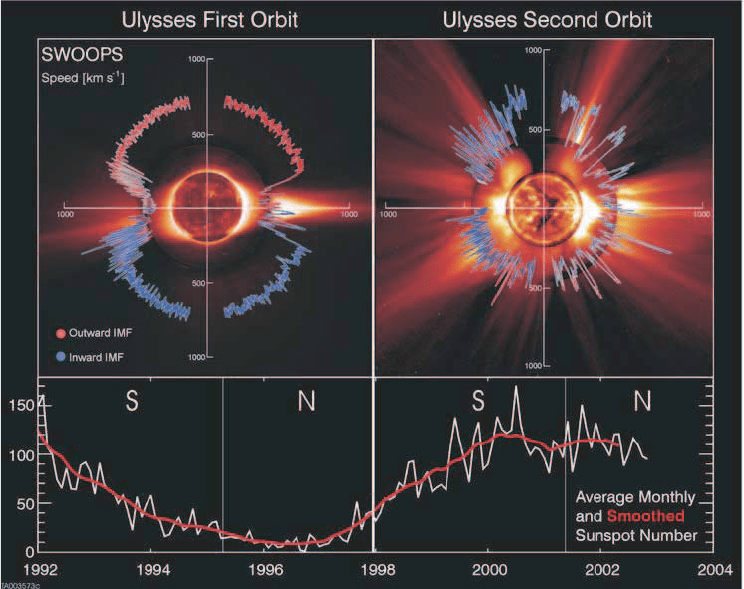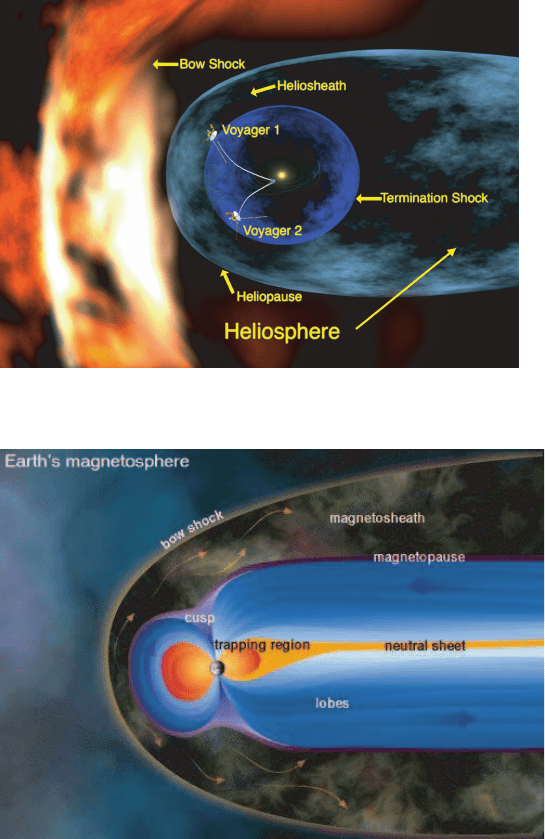Leroy C., Rancoita P.-G. Principles Of Radiation Interaction In Matter And Detection
Подождите немного. Документ загружается.


January 9, 2009 10:21 World Scientific Book - 9.75in x 6.5in ws-bo ok975x65˙n˙2nd˙Ed
310 Principles of Radiation Interaction in Matter and Detection
equator [see Eq. (4.17)]. Finally, since ∇·
~
B = 0, the magnetic field at the point (r,
θ, φ) is [Parker (1958)]
B
r
(r, θ, φ) = B(r
b
, θ, φ
0
) (r
b
/r)
2
,
B
θ
(r, θ, φ) = 0 ,
B
φ
(r, θ, φ) = −B(r
b
, θ, φ
0
) (r
b
/r)
2
(r − r
b
) (ω
c
/v
w
) sin θ.
(4.22)
|
~
B(r, θ , φ)| is given by
|
~
B(r, θ , φ)| = B(r
b
, θ, φ
0
)
³
r
b
r
´
2
s
1 +
·
(r − r
b
)
µ
ω
c
v
w
¶
sin θ
¸
2
, (4.23)
consequently, the magnetic-field strength decreases as 1/r
2
for θ ≈ 0
◦
or ≈ 180
◦
or
for radial distances not too large with respect to r
b
; whereas for r À r
b
it varies as
(sin θ)/r. B(r
b
, θ, φ
0
) represents the field at r = r
b
; under the assumption that only
the solar dipole field threads the escaping gas, then
B(r
b
, θ, φ
0
) = B
0
cos θ, (4.24)
where B
0
is the field strength at the poles. For more complicated field structures,
B(r
b
, θ, φ
0
) can be approximated in a different way, but in either case, the lines of
force follow Eq. (4.22). For instance, if the magnitude of field strength at r
b
≈ 10 R
J
is ≈ 10
−6
T (e.g., see Table 5.2 at page 180 of [Cravens (1997)]), then from the
computation of Eq. (4.23) at Earth orbit (i.e., at ≈ 215 R
J
, see Appendix A.2)
we get a field strength of a few nT. This latter value is in agreement with typical
observed ones. In general, the Parker model agrees with suitable averages of the IMF
over a wide range of heliospheric distances and latitudes. However, for instance, it
has to be noted that the field instantaneous-orientation deviates from that predicted.
Experimental observations allowed one to determine that i) while during solar-
minimum conditions the solar magnetic-field is approximately dipole-like with a
magnetic dipole closely aligned to the solar rotation axis (e.g., see [Smith, Tsurutani
and Rosenberg (1978); Smith (1979); Jokipii and Thomas (1981)]), ii) during the
declining phase of solar cycle the dipole is more tilted (e.g., see [Hundhausen (1977);
Pizzo (1978)]). In addition, as the solar activity approaches its maximum, the large-
scale field seems to be not well described by a dipole field alone. Furthermore, in
1976 observations made using the Pioneer 11 spacecraft up to about 16
◦
above
the solar equatorial plane have shown that a) the magnetic-field sector structure
††
(e.g., see Chapter V of [Hundhausen (1972)]) was dependent on latitude, b) this
sector structure tends to vanish at higher latitudes, where c) the IMF has the sign of
the solar magnetic-field of the appropriate pole. The HMF field-lines consist of those
coming i) from the northern solar magnetic hemisphere and directed away from the
Sun, and ii) from the southern hemisphere and directed towards the Sun. Field
††
At 1 AU, close to the ecliptic plane, the magnetic field typically maintains one direction (either
towards or away from the Sun) for many days. The region of space in which an orientation is
maintained is called sector. Usually, the number of sectors varies from about two to four and it is
related to the solar activity (e.g., see Section 6.4.3 of [Cravens (1997)]).

January 9, 2009 10:21 World Scientific Book - 9.75in x 6.5in ws-bo ok975x65˙n˙2nd˙Ed
Radiation Environments and Damage in Silicon Semiconductors 311
lines
∗∗
from the two hemispheres are separated by a near-equatorial current sheet
([Smith, Tsurutani and Rosenberg (1978)] and references therein), also termed the
heliospheric current sheet (HCS), which is effectively the extension of the solar
magnetic equator into the SW. The average position of the HCS is tilted relative to
the solar equator and warped
k
. Thus, as the Sun rotates, the Earth passes through
the current sheet and, consequently, experiences periods of alternating magnetic-
field polarities. In practice, the maximum solar latitude of the current sheet is almost
equal to the tilt angle of the magnetic dipole axis relative to the rotation axis.
Furthermore, the solar corona is frequently dominated by long-lived structures
which can be reflected by large-flow patterns of the SW. An example is provided
by the so-called corotating interaction regions (CIRs) [Pizzo (1978)]. This dynam-
ical process is related to inhomogeneities (in the coronal expansion), which cou-
ple with the solar rotation, resulting in significant rearrangement of the material
in the interplanetary space: fast streaming material may catch up with slower
streams. Thus, Parker-spiral interaction structures may occur at large heliocen-
tric distances (e.g., see [Pizzo (1978)], Section 12.5 of [Gombosi (1998)], Sec-
tion 6.3 of [Aschwanden (2006)]). This mechanism is responsible for introducing
azimuthal gradients and, in addition, meridional gradients transverse to the eclip-
tic plane. These latter arise because latitude variations stem partly from intrinsic
variations in the corona and partly from the latitudinal dependence of the solar
rotation [e.g., see Eq. (4.17)].
High-speed SW is known to originate from regions close to centers of the so-
called coronal holes
†
[Wang and Sheeley (1993)]. These latter, in turn, are known
to exhibit the unusual property of rotating almost rigidly with an angular rotation
speed similar to that of the solar equator [Timothy, Krieger and Vaiana (1975);
Nash, Sheeley and Wang (1988)], in spite of the differential rotation observed in
the photosphere. Large variations of the SW-structure
∗
(Fig. 4.7) during the solar
cycle [McComas, Elliott, Schwadron, Gosling, Skoug and Goldstein (2003)] and
recurrent energetic particle events (see references in [Fisk (1996)]) were observed
for solar latitudes of ±80
◦
by Ulysses spacecraft, which allowed one to observe SW
properties a) through the declining phase and solar minimum (first orbit) and b)
through the rise to solar maximum, solar maximum and immediately post-maximum
(second orbit).
Fisk (1996) pointed out that there were experimental evidences on how some
modulation and particle acceleration effects can be induced by mechanisms related
∗∗
The configurations of field-lines may exhibit the so-called helmet streamers [Pneuman and Kopp
(1971)] (e.g., see also Section V.6 of [Hundhausen (1972)]), which develop over active regions. The
legs of the helmet streamer connect regions of opposite magnetic polarity.
k
The HCS resembles a ballerina skirt.
†
Coronal holes are regions where the corona is dark and exhibit low X-ray intensity. Coronal holes
are associated with “open” magnetic-field lines [Pneuman and Kopp (1971); Wang and Sheeley
(1993)] and are often found at Sun’s poles (in this case, they are also termed polar holes).
∗
Additional results from Ulysses mission can be found in [McComas et al. (2000); Schwadron,
McComas, Elliott, Gloeckler, Geiss and von Steige (2005)].

January 9, 2009 10:21 World Scientific Book - 9.75in x 6.5in ws-bo ok975x65˙n˙2nd˙Ed
312 Principles of Radiation Interaction in Matter and Detection
Fig. 4.7 Polar plots of SW speed (top panel) as a function of latitude for the first two orbits of the Ulysses spacecraft; sunspot number (bottom
panel) shows that the first orbit occurred through the solar cycle declining phase and minimum while the second orbit spanned solar maximum
(reprinted with permission from McComas, D.J., Elliott, H.A., Schwadron, N.A., Gosling, J.T., Skoug, R.M. and Goldstein, B.E. (2003), The three-
dimensional solar wind around solar maximum, Geophys. Res. Lett. 30 (no. 10), 1517, doi: 10.1029/2003GL017136,
c
°2003 American Geophysical
Union). Both are plotted over solar images characteristic of solar minimum and maximum. The SW speed is color coded by IMF orientation: red
indicates outward pointing IMF, while blue indicates inward pointing.

January 9, 2009 10:21 World Scientific Book - 9.75in x 6.5in ws-bo ok975x65˙n˙2nd˙Ed
Radiation Environments and Damage in Silicon Semiconductors 313
to CIRs at solar latitudes larger than ±30
◦
. It has to be noted that, within this range
of latitudes, CIRs patterns were observed in the SW by Ulysses. In the Fisk model,
the open coronal magnetic-field follows the treatment of Wang and Sheeley (1993)
§
and results from the superposition of an axisymmetric field, which is related to pho-
tospheric material undergoing differential rotation, and a non-axisymmetric field,
which i) originates from decaying active regions near the solar equator, thus, ii)
rotates at the equatorial speed and iii) determines the mechanism by which the
boundary of the coronal holes rotates almost rigidly at the equatorial speed. The
magnetic field in the inner corona of the polar hole can be represented by a tilted
dipole, which has a magnetic axis offset from the solar rotation axis, and which
rotates at the equatorial speed. The interplay among a) the differential rotation
of photospheric material
‡
, b) the SW expansion through the more rigidly rotating
polar holes (which are offset from the solar rotation axis) and c) the tilted mag-
netic dipole results in a SW expansion and, thus, an IMF configuration which can
vary from those predicted by Parker [Smith et al. (1995); Fisk (1996); Zurbuchen,
Schwadron and Fisk (1997); Fisk (1999); Burger and Hattingh (2001); Fisk (2001);
Reinard and Fisk (2004); Schwadron, McComas, Elliott, Gloeckler, Geiss and von
Steige (2005); Zurbuchen (2007)]. In addition, field lines may be moved in latitude
by the CIR mechanism. As a consequence, field lines are allowed to execute large
latitudinal excursions which, for instance, naturally explain 26-day recurrences in
cosmic ray events observed at high latitudes. Experimental observations have given
indication for the validity of this revised heliospheric magnetic-field ([Zurbuchen,
Schwadron and Fisk (1997)] and references therein).
Smith (2004) (see also references therein) has reviewed the characteristics of the
radial, azimuthal and North–South components of the magnetic field in the outer
heliosphere. He pointed out that recent Ulysses measurements, at both solar mini-
mum and maximum, indicate that i) the radial component is almost independent of
solar latitude, ii) the azimuthal component deviates from the Parker values at high
latitudes (e.g., see [Banaszkiewicz, Axford and McKenzie (1998)]), iii) a turning of
the spiral angle toward the radial direction by tens of degrees is often observed inside
the so called corotating rarefaction regions (CCR) [Murphy, Smith and Schwadron
(2002)] and iv) the North–South component can depart from zero for many days as
a result of the tilting of the interface between fast and slow SW streams.
4.1.2.2 Extension of the Heliosphere and the Earth Magnetosphere
Parker (1961b) was the first to investigate the extension of the heliosphere. Al-
though since then more work has been done on this topic, details of the SW inte-
raction with the interstellar medium are mostly speculative because we lack ex-
§
The reader can find additional information in [Sheeley, Nash and Wang (1987); Nash, Sheeley
and Wang (1988); Wang, Sheeley, Nash and Shampine (1988)] and references therein.
‡
The heliospheric magnetic-field lines in high sp eed streams are assumed to be anchored in the
differentially rotating photosphere.

January 9, 2009 10:21 World Scientific Book - 9.75in x 6.5in ws-bo ok975x65˙n˙2nd˙Ed
314 Principles of Radiation Interaction in Matter and Detection
tensively direct observations of this space region (e.g., see Chapter IX of [Parker
(1963)], Section 1.3 of [Toptygin (1985)], [Suess (1990)], Section 6.61 of [Cravens
(1997)], Section 12.7 of [Gombosi (1998)], Section 9 of [Gosling (2006)] and refe-
rences therein). Parker (1961b,1963) predicted the existence of i) the heliospheric
termination shock which results because the SW, that is flowing supersonically away
from the Sun, must make a transition to subsonic
∗∗
and ii) the heliopause, which
is the boundary surface separating the interstellar and SW plasmas and it is lo-
cated outside the termination shock (Fig. 4.8). A rough estimate of the heliopause
location may be obtained from balancing the SW pressure, P
w
, and the interstellar
medium pressure, P
IS
, i.e.,
P
w
= P
IS
. (4.25)
Since the thermal and magnetic pressure
††
components of the SW can be neglected
{e.g., see Equations (7.17–7.21) at page 349 of [Meyer-Vernet (2007)]}, P
w
is prac-
tically given by the SW dynamic pressure P
d,w
(also termed the ram pressure of the
SW ), i.e.
P
w
∼ P
d,w
(4.26)
with (e.g., see Section 7.2.1 of [Meyer-Vernet (2007)])
P
d,w
= ρv
2
w
, (4.27)
where ρ and v
w
are the SW-plasma mass density and speed, respectively. Under
steady-state spherically symmetric condition, the continuity equation [Eq. (4.5)]
becomes
n
pl
v
w
r
2
= constant ∼ n
1AU
v
w,1AU
× (1 AU)
2
,
∗∗
The behavior of gas depends on the sp eed of sound v
sd
[Eq. (4.6)], which controls the propagation
of disturbances. In the SW, particles are also linked by their embedded magnetic-field, thus, by
the “magnetic pressure” and, in turn, by the “Alfv´en speed”, v
A
,
v
A
=
|
~
B|
√
µ
0
ρ
,
where ρ is the plasma mass-density and µ
0
is the permeability of the free space. The local fast
mode speed is the characteristic speed with which small amplitude pressure signals propagate in a
plasma and it is given by
v
f
=
q
v
2
sd
+ v
2
A
.
At 1 AU, the mean values of v
sd
and v
A
in units of km/s are 63 and 50, respectively (Table 1 at
page 101 of [Gosling (2006)]).
††
The magnetic pressure is given by:
P
M
=
|
~
B|
2
2µ
0
,
where µ
0
is the permeability of the free space (e.g., see Section 4.5.1 of [Cravens (1997)]). In cgs
units it takes the form
P
M
=
|
~
B|
2
8π
dyn/cm
2
with
~
B in units of Gauss. It can be described as the tendency of neighboring field lines to repulse
each other. Note that, in contrast to the gas-dynamic pressure, the magnetic pressure is not
isotropic but is always perpendicular to the field (e.g., see Section 3.3.1 of [Kallenrode (2004)].

January 9, 2009 10:21 World Scientific Book - 9.75in x 6.5in ws-bo ok975x65˙n˙2nd˙Ed
Radiation Environments and Damage in Silicon Semiconductors 315
where n
pl
≈ ρ/m
p
is the number of protons
‡‡
per cm
3
in the SW plasma [e.g., see
Eq. (4.4)]; n
1AU
and v
w,1AU
are the SW-plasma density and speed at 1 AU, respec-
tively. Thus, as discussed at page 308, under the assumption that the SW speed is
already almost constant beyond the Earth, i.e.,
v
w
≈ v
w,1AU
for r & 1 AU,
we have
n
pl
∼ n
1AU
µ
1 AU
r
¶
2
. (4.28)
Using Eqs. (4.4, 4.28), the ram pressure can be expressed in terms of the SW
characteristics at 1 AU by re-writing Eq. (4.27) as
P
d,w
≈ n
pl
m
p
v
2
w
≈ n
1AU
m
p
v
2
w,1AU
µ
1 AU
r
¶
2
= P
1AU
µ
1 AU
r
¶
2
, (4.29)
where {see Equation (7.18) at page 349 of [Meyer-Vernet (2007)]}
P
1AU
= (2.1–2.6) × 10
−8
dyn/cm
2
(4.30)
is the dynamic pressure
¶
at 1 AU. The interstellar medium pressure P
IS
is given by
the sum of i) the magnetic-field pressure, ii) the thermal pressure of the interstellar
plasma, iii) the dynamic pressure of the interstellar plasma and iv) the cosmic rays
pressure. Suess (1990) estimated that
P
IS
≈ (1.3 ± 0.2) × 10
−12
dyn/cm
2
,
thus, from Eqs. (4.25, 4.26, 4.29), we obtain that the distance R
hp
of the heliopause
from the Sun is related by
P
IS
= P
1AU
µ
1 AU
R
hp
¶
2
(1.3 ± 0.2) × 10
−12
≈ (2.1–2.6) × 10
−8
µ
1 AU
R
hp
¶
2
and, consequently, we get
R
hp
∼
s
(2.1–2.6) × 10
−8
(1.3 ± 0.2) × 10
−12
AU
≈ (1.18–1.54) × 10
2
AU. (4.31)
Since the distance of the heliopause from the Sun is large [Eq. (4.31)], the IMF
embedded in the SW cannot be considered to instantaneously propagate through
‡‡
For this approximate calculation the small portion of helium in the SW was neglected.
¶
Equation (4.30) can be equivalently expressed as: P
1AU
= (2.1–2.6) × 10
−9
Pa.

January 9, 2009 10:21 World Scientific Book - 9.75in x 6.5in ws-bo ok975x65˙n˙2nd˙Ed
316 Principles of Radiation Interaction in Matter and Detection
the solar cavity. In fact using Eq. (4.31) (see also Appendix A.2), a rough estimate
of the traveling time (τ
hp
) through the heliosphere up to the heliopause is given by:
τ
hp
≈
R
hp
v
w,1AU
=
(1.18–1.54) × 10
2
× 1.496 × 10
8
km
470 km/s
= (3.76–4.90) × 10
7
s ∼ (1.19–1.55) y, (4.32)
where v
w,1AU
≈ 470 km/s is the average value of SW speed already almost constant
beyond the Earth (e.g., see pages 300, 308). As a consequence, the structure of
the IMF depends on the past solar-activity occurred during more than a year. Fur-
thermore, an additional complexity is added to the IMF structure by the delayed
propagation of phenomena affecting the SW, for instance those observed at large
solar latitudes and discussed at pages 311-313.
Voyager 1 spacecraft has already verified the existence of the termination shock
at a heliocentric distance of ≈ 94 AU roughly in the direction of the relative motion
of the heliosphere relative
∗
to the interstellar medium (e.g., see [Cummings, Stone,
McDonald, Heikkila, Lal and Webber (2005)]) and entered the heliosheath, which is
located between the termination shock and the heliopause (Fig. 4.8).
Outside the heliopause the interstellar flow is deflected around the helio-
sphere. Furthermore, if the external flow speed is larger than the fast mode speed
(see footnote at page 314), it is expected the formation of a bow shock to deflect the
interstellar flow around the heliosphere. The shape of the heliosphere is asymmet-
ric (Fig. 4.8), because of its motion relative
∗
to the interstellar medium, and it is
largely elongated in the opposite direction, thus, generating the so-called heliotail.
Furthermore inside the heliosphere, the Earth’s magnetosphere is the region of
space to which the Earth’s magnetic-field
k
is confined by the SW plasma and, thus,
shaped (Fig. 4.9) by its interaction with the SW itself (e.g., see [Knecht and Shuman
(1985); Kivelson and Bagenal (2006); Luhmann and Solomon (2006); Schulz (2007)]
and references therein). This cavity was named magnetosphere by T. Gold in 1959 to
provide a description of the space region above the ionosphere. The first suggestion
of such a cavity (sometimes referred to as the Chapman–Ferrero cavity) was made
by S. Chapman and V. Ferraro in 1930.
The space environment of the Earth is determined by its almost dipolar inter-
nal magnetic-field that forms an obstacle to the SW with its embedded magnetic-
field. Thus, to first approximation, the magnetic field close to the Earth surface has a
dipole shape, but moving outwards other contributions become important. Among
these we have to mention, for instance, those resulting from the several currents
(e.g., the ring current, Birkeland’s currents and tail currents) due to charged par-
ticles trapped inside the magnetosphere (Sect. 4.1.2.5). Moreover the latitudinal
∗
The Sun and heliosphere move at a speed of ≈ 23 km/s relative to the interstellar medium.
k
Note that a number of coordinate systems are employed in the description of geomagnetic
phenomena; among the commonly used are geographic, geomagnetic, geocentric solar-ecliptic,
geocentric solar-magnetospheric and solar-magnetic coordinate systems. The reader can find the
definitions, for instance, in Section 4.1.2 of [Knecht and Shuman (1985)].

January 9, 2009 10:21 World Scientific Book - 9.75in x 6.5in ws-bo ok975x65˙n˙2nd˙Ed
Radiation Environments and Damage in Silicon Semiconductors 317
Fig. 4.8 Schematic representation of the heliosphere with Voyager 1 spacecraft crossing into the
heliosheath, the region where interstellar gas and solar wind start to mix. (Courtesy NASA/JPL-
Caltech).
Fig. 4.9 Schematic representation of the magnetosphere to which the Earth’s magnetic-field is
confined and, thus, shaped by the SW plasma (Courtesy of NASA’s Marshall Space Flight Center
and Science@NASA).
dependence is not geographically symmetric, because the Earth magnetic dipole is
tilted with respect to the Earth rotation axis and shifted from the Earth center. The
magnetic field of the Earth magnetosphere can be described (e.g., see Appendix A
of [Bobik et al. (2006)] and Section 7.2 of [Schulz (2007)]) using i) the Interna-
tional Geomagnetic Reference Field (IGRF) [Barton (1997)] for representing the

January 9, 2009 10:21 World Scientific Book - 9.75in x 6.5in ws-bo ok975x65˙n˙2nd˙Ed
318 Principles of Radiation Interaction in Matter and Detection
main contribution due to the inner Earth and ii) the external magnetic field model
implemented by Tsyganenko and Stern (e.g., see [Tsyganenko (1995); Tsyganenko
and Stern (1996)]) for representing the other contributions.
Similarly to the formation of the heliopause discussed above, the magnetopause
is the location where the outward magnetic pressure (see footnote at page 314) of the
Earth’s magnetic-field is counterbalanced by the SW pressure, which is practically
given by the SW dynamic pressure at 1 AU (P
1AU
) [see Eq. (4.30)], since the thermal
and magnetic combined pressure is less than 1% of the SW ram-pressure [e.g., see
Equations (7.17–7.21) at page 349 of [Meyer-Vernet (2007)]]. The subsolar distance
‡
(R
EM
) of the magnetopause can b e estimated in SI units from
P
1AU
≈
FB
2
e
µ
0
µ
Re
R
EM
¶
6
, (4.33)
where F ≈ 2 is a magnetic-field compression factor (e.g., see Section 14.2.2 of [Gom-
bosi (1998)] and, also, Section 8.2.2 of [Kallenrode (2004)]), µ
0
is the permeability
of the free space, B
e
≈ 3.11 ×10
−5
T is the equatorial magnetic-field
§
at the surface
of the Earth and Re is the radius of the Earth (Appendix A.2). From Eq. (4.33),
we get:
R
EM
≈
6
s
FB
2
e
µ
0
P
1AU
Re (4.34)
≈ (9.2–9.5) Re.
Thus, on the dayside of the planet, for normal SW conditions the subsolar distance of
the magnetopause is ≈ 10 Re. However, when the SW pressure is particularly strong,
this distance can be reduced to ≈ (6–7) Re. On the nightside, the magnetosphere is
stretched into a long magnetotail to a distance, which might extend up to ≈ 1000 Re
(Fig. 4.9). The magnetotail has an approximate cylindrical shape of ≈ 40 Re in
diameter.
Since the SW is a supersonic flow, a standing shock wave, the bow shock
¶
, de-
velops in front of the magnetopause. Its subsolar distance (R
BS
) is typically located
(2–3) Re ahead of this latter and is approximately given by (e.g., see Equation 14.18
at Page 284 of [Gombosi (1998)])
R
BS
≈ 1.275 × R
EM
.
At the bow shock the SW plasma is slowed down to subsonic speed and a substantial
fraction of its energy is converted into thermal energy. The thermalised SW flow
passes through the bow shock and enters the region called magnetosheath, but can-
not easily penetrate through the magnetopause. However, Dungey (1961) suggested
‡
The subsolar distance is the radial distance towards the Sun to the nose of magnetopause. The
subsolar point on Earth is where the Sun is perceived to be directly overhead.
§
The dipolar magnetic-field flux-density falls off with the distance r as 1/r
3
.
¶
A further discussion about the bow-shock formation and location can be found in [Schwartz
(1985)].

January 9, 2009 10:21 World Scientific Book - 9.75in x 6.5in ws-bo ok975x65˙n˙2nd˙Ed
Radiation Environments and Damage in Silicon Semiconductors 319
that the magnetopause i) is not a complete barrier to the SW and ii) the magneto-
sphere structure itself is also controlled by its reconnection with the IMF. Further-
more, the magnetic field exhibits the polar cusps, which separate closed field lines
on the dayside of the magnetosphere from field lines swept to its nightside and to
which the field lines of the magnetopause converge (Fig. 4.9). The cusp regions are
filled with plasma particles from the magnetosheath and, thus, at the cusps these
particles can penetrate deep into the Earth’s atmosphere. Close to the Earth, in the
inner magnetosphere the dipolar shape of the magnetic field is almost preserved.
4.1.2.3 Propagation of Galactic Cosmic Rays through Interplanetary Space
The Galactic cosmic radiation [e.g., the Galactic Cosmic Rays (GCRs), see
Sect. 4.1.2.4] is incident on the solar cavity isotropically and constantly and is af-
fected by the outwards flowing SW with its embedded magnetic-field and magnetic-
field irregularities. For instance, at energies
∗
below a few GeV/nucleon, the inten-
sity shows a strong dependence on solar activity (e.g., see Sect. 4.1.2.1) with a
maximum at the solar minimum and decreases with increasing the solar sunspot
numb er [Smart and Shea (1985)]. This effect is called modulation of GCRs. Fur-
thermore, differential energy spectra of all high-energy isotopes exhibit a maximum
[Fig. 4.12(a) and Fig. 9.37], which shifts towards higher energies and, at the same
time, decreases in intensity with increasing solar activity: this effect was observed at
1 AU for protons and other isotopes up to iron [Meyer, Parker and Simpson (1974);
Webber and Lezniak (1974); Simpson (1983); Smart and Shea (1985, 1989)].
Parker (1963,1964,1965) proposed a theory for the general properties of the prop-
agation of GCRs through the interplanetary space, considering transit time, energy-
loss and the outward convection of solar particles. Furthermore, he reached the con-
clusion that the SW, and in general the IMF configuration which results, lead to
important cosmic rays modulation-effects dependant on the solar activity. He based
his theory on IMF observations made by the Explorer XVIII spacecraft: the IMF
recorded-variations were magnetic-field spatial irregularities transported rigidly in
the SW (Figure 1 of [Parker (1965)]). These irregularities appear with dimensions
of 10
5
–10
7
km, which, for instance, are comparable with the radius of gyration of
protons with kinetic energies larger than ≈ 100 MeV and lower than ≈ 10 GeV in a
typical IMF of a few nT. He succeeded in showing that a charged particle, moving
in a large-scale field containing small-scale irregularities, is most effectively scat-
tered by irregularities which have a scale comparable to the radius of gyration of
the particle [Parker (1964)]. When this occurs, the effect of such irregularities is to
cause (in the reference frame of the magnetic irregularities) the GCRs to a random
walk, which can be considered as a Markhoff process
§
.
∗
The reader can find the definition of kinetic energies per nucleon in Sect. 1.4.1.
§
A Markhoff process is when the value of a physical parameter at the next measuring time
depends only on its value at the present time and not on its value at any previous measuring time,
i.e., the system has one time step (or less) “memory”.
